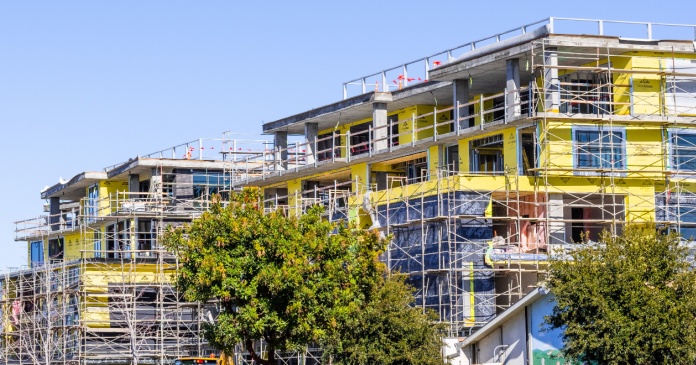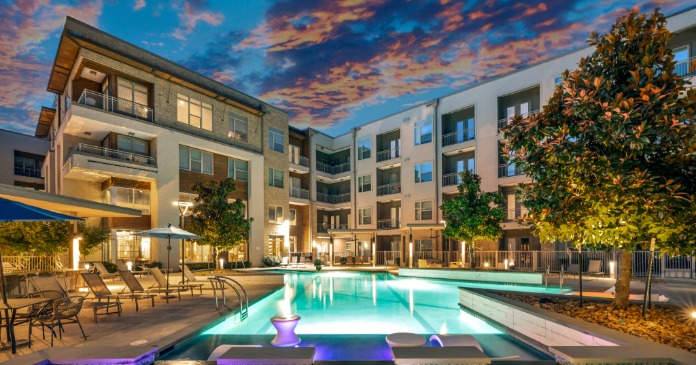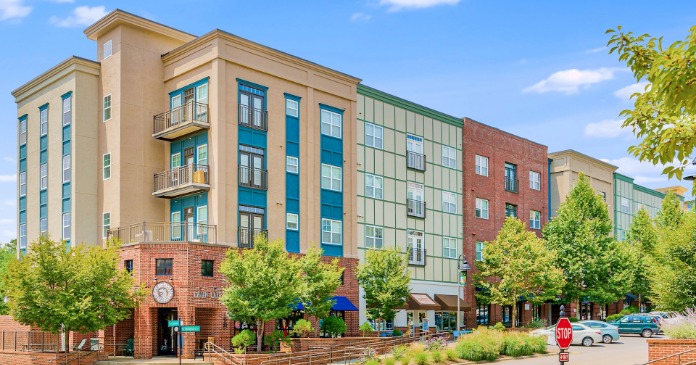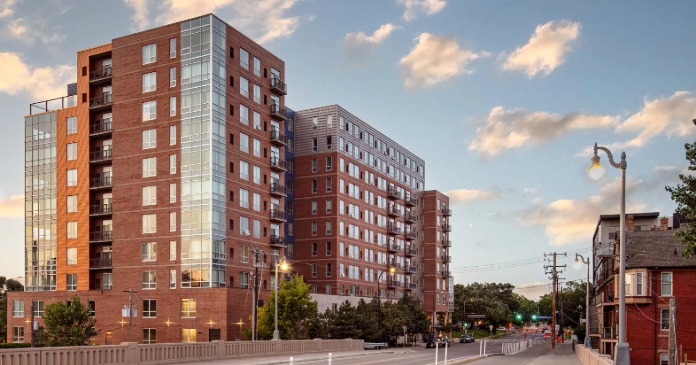Yield PRO TV presents NAHB Power Hitters. Host Linda Hoffman talks with Audra Hamernik, President and CEO of Nevada HAND.
Transcript: NAHB Power Hitters interview. Linda Hoffman with Tom Skaar, recorded June 16, 2022
(music)
Linda Hoffman: The Biden Administration has announced its plan to make generations of under building a distant memory. This may be a name that goes down in history so take special note: The Housing Supply Action Plan.
The nation’s housing shortage, decades in the making, has long been a drag on our national productivity, well-being and psyche. But the Housing Supply Action Plan promises not only to increase affordable inventory, but to eliminate the shortfall inside five years. How on earth, you ask?
Certainly a lot of the smartest people have given this a lot of thought. Much has been studied. Much more has been written. So what’s the final word?
Expanding federal financing for multifamily—it’s in there. So is manufactured housing. Perhaps the one that caught my attention was the part about “working with the private sector to address supply chain challenges and improve building techniques.” OK, maybe it was the fact that private and government appeared in the same sentence that got me excited. Historically those unions have had some of the greatest success. Hope springs eternal and we shall see.
A far more sure bet is today’s guest. She may be the ace of the base in creating and operating successful affordable product. Audra Hamernik is CEO of Nevada HAND. Audra is in the business of delivering affordable housing to the great state of Nevada. This includes workforce and senior housing and so much more.
It’s great to see an organization with as much impact as Nevada HAND has had on the state. Audra, it’s great to have you on the show.
Audra Hamernik: Thank you so much for having me.
Linda Hoffman: Let’s start at the beginning. Tell us about yourself and Nevada HAND.
Audra Hamernik: Oh, thank you. So I’ve been in affordable housing for around 25 years and I’ve worked for County governments in administering federal funds that come through for housing. I’ve had a consulting firm where I’ve helped nonprofits access funds to build and support residents in affordable housing. I’ve worked for state government. Most recently I was the executive director of the Illinois Housing Development Authority, which was a lender and also allocated tax credits for the state of Illinois. And now I’m president and CEO of Nevada HAND.
And Nevada HAND is the largest affordable housing developer in Nevada and we happen to be a nonprofit. And we are a very vertically integrated company. We have our own development team, our own construction firm. We do our own property management. We have resident services coordinators at every site and we also own two affordable assisted living communities. We serve around 8,000 residents a year, all in Southern Nevada, and we have around 4,700 affordable apartment units in our portfolio. So with about 300 staff members, we are out and about and busy trying to think through all the ways that we can better serve the low income folks that live in Southern Nevada.
We have, right now, 700 units under construction and 200 units being rehabbed. So we can preserve the affordable housing for the folks who are living in those units. So that’s, in a nutshell, that’s who we are.
Linda Hoffman: Well, Nevada HAND operates exclusively in the Las Vegas metro area, a region particularly hard-hit by COVID lockdowns. How did the downturn impact your residents and how’s it going now?
Audra Hamernik: Oh that’s a great question. You are absolutely right. Nevada was very hard hit during COVID. I can say that we had a very quick bounce though and we have bounced back. It went deep quick and it went up quick again. So the good news is I think that we really are on a path for full recovery. Visitors to Las Vegas in the area are at record high, including international visitors. The gaming records, they’ve really hit above pre-pandemic levels at this point. And it’s really a hot market in the industrial, commercial, and even office space.
You would think during the pandemic that the office space may flatten out, but we are not seeing it here. I’m hearing from our industrial and office commercial friends that they are 90 percent leased on every product that’s been built now, until 2023. So they’re pre-leasing office. It’s just amazing to me. High population growth all through Nevada. And I just read in the newspaper this morning that Las Vegas Airport has had the best capacity recovery of any airport in the world.
So I think that we feel really good that it is recovering and if we were in the same city, Linda, I would ask you to hop in my truck and we could go drive around the city and I bet I could show you 75 active cranes. So it is a really hot construction market.
I could tell you that one of the down things that we’re dealing with right now is labor market. It’s really been difficult to find and retain employees. I think that’s a pretty common concern among all construction and real estate industries right now. But to answer your question, how are our residents doing? During the pandemic, you know, it really did affect our family properties more than it did our seniors. Our seniors were typically on fixed incomes and they didn’t really have a COVID impact because they didn’t lose a job. Now our family side, our worst, at the very worst it was 85 percent collections; and that’s seven times worse than what our normal collections would be. So that was problematic.
But through payment plans, through working with our tenants and then also the federal rental assistance that came through, it really did keep people housed. So the plan worked. I can also say that it was interesting because we did have a handful, and out of approximately 8,000 of the residents that we serve, we had a handful that didn’t have COVID impact and decided not to pay. And then we had some that exhausted their ability to get rental assistance because you can only have so much over so many periods of months.
So we think that that’s terrific. Right? If we have a handful out of 8,000 that had some issues, that’s not bad. I think for the most part our residents are doing great right now. They, there’s no shortage of jobs and our rental payments are back where they should be and we are very happy that we were in a position that we were in a position that we didn’t have to evict anyone for not paying their rent.
Linda Hoffman: That’s great news. Las Vegas is growing rapidly, this along with the fact that this metro is a much higher percentage of renters than the rest of the country makes me wonder. Is housing supply keeping up?
Audra Hamernik: Oh. No. There’s a huge mismatch between supply and it’s really interesting. There’s 44 percent of Nevadans are renters. That’s such a high percentage of renters, that it’s just not even, our supply and demand is just not working in the market environment and it’s certainly not working in the affordable housing market.
We, in 2019, was the first time I saw these numbers and we were about 79,000 affordable apartment units short. That number, it just in three years it increased to 85,000 units short. And you know we, we want to pat ourselves on the back at Nevada HAND and say oh, we’ve got 700 under construction, but we realize it’s a drop in the bucket in need. So we’re humbled by that number and we want to help as many people as possible, but recognize that there’s some resources that we need help with.
And just to give you a little bit of context, right now, the newspaper’s telling us that the average monthly rent in Las Vegas is around $1,400 a month. And our average rent at Nevada HAND is around $733 a month. So you can see that there’s, you know, there really is a demand for low-income housing. We’re getting about 2000 calls a day from people in need, you know, asking if we have vacant units. And unfortunately, we just don’t. The last number I saw was 15 vacant units out of 4,700 and, you know that we have long wait lists at those properties, so we don’t necessarily have the best news when people call, but we have new properties coming online that they can certainly get in line for.
Linda Hoffman: Two-thirds of your portfolio is senior housing. Nevada HAND also operates 12 non-senior affordable communities. There you include resident support services—services proven beneficial to community health and stability. Do these services enable residents to improve their finances to the point they can move on to market-rate properties?
Audra Hamernik: Oh. That’s a good question. OK, so both our senior properties and our family properties have resident services coordinators, and they really are the heart and soul of our properties, along with our property managers and our maintenance staff. Believe it or not, if you would talk to some of our maintenance men they feel like they are the face of Nevada HAND because they know the residents and they know whose children, you know, belong to whose, so, the residents service coordinators that are, really act as a liaison between the resident and what the resident needs.
So it could be a health and wellness issue. It could be an education issue. It could be community engagement. It could be financial stability. So during COVID our resident service coordinators were working hard helping people complete those online applications for rental assistance or maybe it was utility assistance. We have food programming in some of our senior properties where we have food pantries. So every week folks can come and order food and, you know, have a week’s worth of food. We have transportation services at our senior properties. And depending on what property it is and what need is there, we might have a particular need for English as a second language classes. Maybe residents say that they would like some help with smoking cessation classes. Maybe there’s particular homework help that residents want and need for their children. So it’s a variety of services that resident services provides.
So if we would’ve had this, your question, before the pandemic—we did a study and we asked ourselves, looking at the data that we have, over the last three years, where are residents going when they leave Nevada HAND? And we found that, on our family properties, 10 percent of our families were leaving and going straight into homeownership. And, so, I am really thrilled because there are many of our residents, that they just need an affordable place. They’re working. They’re, you know, they have stable lives. Right? They just need affordable housing. Then we have other residents who have a lot more complicated needs. Our resident services coordinators are there helping them provide those services or they’re linking them to other services within the community to help them.
So I think that for our seniors, you know, we don’t expect them to necessary move on. We think that we want to give them a really dignified way to age in place in their apartment and add services to their household as they need them. And then our families, sometimes they move on in homeownership, sometimes they’re getting other types of jobs, sometimes they’re getting married, sometimes they are graduating from a program. So some move on and then some stay but, it’s, we celebrate every single one of those successes.
Linda Hoffman: So, Audra, what’s the best way to support residents rising economically?
Audra Hamernik: Oh. For us, you know, it really depends on the household need. So, once a year our resident services meets with the household, and they, you know, they’re friends. They know them. So when they’re coming in for an annual assessment isn’t the first time that they’ve seen that household throughout the year.
We were just at a site recently; the HUD secretary actually was doing a tour and our resident services coordinator was there. All those kids, it was a family property, the kids running up. He was passing out popsicles. They knew his name. He knew their’s, so you know, there’s a relationship that’s there. So when they’re sitting down for their annual assessment, it’s not like it’s the first time. And they’re really able to ask some frank questions like what can we do to assist you? Where, when you’re looking at your monthly budget are there things that we can help you with, or help you think through? Do you need utility assistance or maybe there’s a food program that we can help you, so that you have other income to do other things.
So it really depends on the family and what their needs are and how we’re able to plug in and provide a resource.
Linda Hoffman: In recent testimony before Congress, you called for more spending on a variety of Federal programs including LIHTC, the National Housing Trust Fund, Section 202 Supportive Housing for the Elderly, Section 811 Supportive Housing for People with Disabilities, and the HOME Investment Partnerships program. If you had to pick just one of these programs for increased funding, which would it be and why?
Audra Hamernik: Oh. Hands down. Low Income Housing Tax Credits. When we are looking at a new property and we’re looking at that capital stack, the sources that pay for the development of the deal, 70 to 80 percent of the capital comes from low-income housing tax credits. So it is absolutely a critical source of financing. And frankly, all of the other sources that you’ve mentioned are very helpful, but they’re only gap fillers. They never really contribute that much to the capital stack.
So the Low Income Housing Tax Credit, I believe, it’s, of the multifamily housing asset trading of the United States—90 something percent is using the housing tax credits. In your introduction, when you were talking about public-private partnership, that’s immediately what went to my mind because the investors that buy the tax credits from us—they would never be investing in the affordable housing marketplace in the same way without getting that tax credit. And it’s really interesting because not only are they buying tax credits, they’re also buying the depreciation of the building. So all that affects the pricing and it really is bringing a completely different investor into the affordable housing market that would never, ever be looking at us as a partner without that Low Income Housing Tax Credit program.
Linda Hoffman: Also in your testimony, you cited the lack of affordable, developable land impacting affordable supply. Outsiders see Las Vegas as a city surrounded by endless desert. What is limiting the supply of land there?
Audra Hamernik: Okay. That is a really good question because it really does look like, when you fly in, that there’s land everywhere. You know, in Southern Nevada in particular, we’re kind of an island in the desert. Eighty-six percent of Nevada is owned by the federal government. So a lot of that land that looks vacant isn’t developable in the same way as it would be other states.
I’ve learned a lot about the Bureau of Land Management and its federal programs on reserving land, and we’re fortunate that there is a program that reserves that local… local jurisdictions can reserve land specific for affordable housing and that is happening in Southern Nevada, for sure. And Senator Cortez Mastro has a Clark County land bill that she has introduced that is trying to reserve more of that federal land for conservation and affordable housing. So we live in hope that some of that land will eventually end up being available for developers like us to buy and build on for affordable housing.
So it looks strange, right? All this land but, they’re working on ways to provide more access to affordable housing.
Linda Hoffman: An unusual feature of Nevada HAND is that you operate as a 501(c)(3) non-profit. You mentioned that previously. How does this corporate structure affect your business operations, positively and negatively?
Audra Hamernik: You know, it’s interesting because we look a lot like a private real estate development company. Right? And we operate very much like a private real estate, in the same way that—we just talked about land shortage. I mean, we’re competing with land with every other real estate buyer in the marketplace. So I think there are some positives and I think there are some negatives. So, for example, our resident services coordinators, they are paid through our profit. Right? And we’re also out there looking for donors to donate to Nevada HAND to pay for those services that we provide to residents. And sometimes we don’t look enough like a normal nonprofit, right? People look and think, well, why would you be asking for donations? Well, we are a 501c(3). So we are a secret in the community when it comes to that.
On the other hand, we do have some foundations that look at us and they look at our business practice and look at how we think about continuous improvement and making our procedures and processes easier, better, faster, cheaper, and they look at our balance sheet and they are, really want to invest in us because they know that we are a non-profit that’s really not going away, and that we’ve been in operation for 29 years.
So there are some positive and negatives, but we, for the most part, find that it’s a terrific balance because our mission is very, very clear—that we want to help people and help them live well, and most of our funders, I think, appreciate the fact that they understand that our, the profit that we’re making on our deals, is the way that, for the very next deal, we’re paying for the architect, we’re paying for the land, we using that to reinvest, to make that next deal happen.
Linda Hoffman: Several members of your board of directors are residents of your communities. What special perspective do they bring to the board’s deliberations?
Audra Hamernik: You know, we talked a little bit about continuous improvement in that last question. And one of the principles is called go to the gemba. So go to the experts. And I think having a residents on our board help us go to the experts because they really understand in a very meaningful way what it’s like to live in one of our buildings and see what works and doesn’t work with resident services. See, for example, it could be something very simple like, pay your rent online. Right? Or would you rather write a check and submit it to the office? We’re learning from them all sorts of very specific things that help us provide better services to them and other residents. So we think it’s terrific and we learn a lot from them.
Linda Hoffman: What a fun and informative show. Thank you for joining us Audra. You have knowledge the nation greatly needs.
Audra Hamernik: Great. Thank you so much and we really appreciate you taking the time to get to know us.
Linda Hoffman: It’s not hard to find those in the business who have forged a path of success. And it doesn’t take a genius to know that those are the ones to follow. I suspect Audra has only begun to change the landscape of affordable housing in her state. Let’s hope it becomes a pattern across the nation.
I’m Linda Hoffman. See you on our next exciting episode of NAHB Power Hitters.
(music, close, credits)
NAHB POWER HITTERS (logo)
In association with National Association of Home Builders (logo)
Building Homes, Enriching Communities, Changing Lives
Yield Pro TV (logo)
An Image Production
Host Linda Hoffman
Executive Producer Andrew Nicks
Research Michael Rudy
Guest selection and coordination Dean Schwancke
Production Image
Yield Pro TV is a production of Multihousing Professional magazine corporation and may not be reproduced or copied in whole or in part without the expressed permission of the publisher.
©2022 Yield Pro, LLC.












